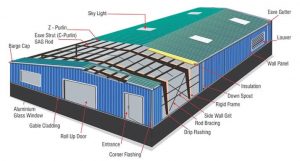How to Design an Efficient Warehouse Structure
Designing a warehouse structure is a critical task that can significantly impact the efficiency and productivity of your business operations. Whether you are setting up a new warehouse or optimizing an existing one, a well-planned warehouse design can streamline processes, reduce operational costs, and enhance overall performance. In this article, we will explore the key considerations and steps to create a warehouse structure that meets your business needs. How do you design a warehouse structure?
Understanding Your Warehouse Needs
Before embarking on the design process, it’s essential to understand your specific warehouse requirements. This step is crucial as it sets the foundation for the entire design process. Here are some key factors to consider:
Inventory and Storage Requirements
Begin by analyzing your inventory and storage needs. Determine the types of products you will store, their dimensions, and the volume of goods to be accommodated. This information will help you decide on the appropriate storage solutions, such as pallet racks, shelving units, or automated systems.

Workflow and Process Analysis
Study your existing workflows and operational processes. Identify areas of inefficiency, bottlenecks, and opportunities for improvement. By understanding how materials flow through your warehouse, you can design a layout that optimizes productivity.
Space Utilization
Consider the available space for your warehouse. Take into account the building’s dimensions, ceiling height, and any existing infrastructure. A thorough analysis of the available space will help you make the most of it while ensuring safe and efficient operations.
Warehouse Layout Planning
Once you have a clear understanding of your warehouse needs, it’s time to start planning the layout. The warehouse layout is a critical aspect of the design process, and it should be tailored to your specific operational requirements.
Zoning
Divide your warehouse into functional zones. Common zones include receiving, storage, picking, packing, and shipping. Zoning helps streamline operations by ensuring that similar tasks are grouped together, reducing unnecessary travel within the warehouse.
Aisles and Paths
Carefully plan the placement of aisles and paths within your warehouse. The width of these paths should accommodate the movement of equipment, such as forklifts or pallet jacks. Well-designed aisles help prevent congestion and improve overall safety.
Vertical Space
Make efficient use of vertical space by utilizing high-bay racking and mezzanines. This can significantly increase your storage capacity while keeping the warehouse organized and accessible.
Warehouse Storage Solutions
Selecting the right storage solutions is a critical aspect of warehouse design. The choice of storage systems should align with your inventory and operational requirements.
Pallet Racking Systems
Pallet racking systems are versatile and suitable for storing large quantities of palletized goods. Choose the right racking type, such as selective, drive-in, or push-back, based on the characteristics of your products and the way you manage inventory.
Shelving Units
Shelving units are ideal for smaller items and can be used for order picking and organization. Consider adjustable shelving to accommodate changes in product dimensions and inventory rotation.
Automated Systems
Automation technology, such as automated storage and retrieval systems (AS/RS) and conveyor systems, can greatly enhance warehouse efficiency. These systems are particularly valuable for high-throughput operations.
Safety and Compliance
Safety should be a top priority when designing a warehouse structure. Compliance with safety regulations and industry standards is essential to prevent accidents and ensure the well-being of your staff.
Fire Safety
Implement fire safety measures, including fire suppression systems, fire exits, and proper storage of hazardous materials. Regular fire drills and employee training can also enhance safety.
Ergonomics

Consider ergonomics when designing workstations and picking areas. Properly designed workspaces reduce the risk of injuries and promote employee well-being.
Compliance with Regulations
Ensure your warehouse design complies with local building codes and occupational safety regulations. Regular inspections and maintenance are crucial to staying compliant.
Technology Integration
Incorporating technology into your warehouse design can lead to improved efficiency and accuracy in your operations.
Warehouse Management Systems (WMS)
Implement a WMS to streamline order processing, inventory tracking, and reporting. A good WMS can optimize stock levels and reduce errors.
Barcode and RFID Systems
Utilize barcode and RFID technology for accurate tracking and management of inventory. These systems enhance visibility and reduce the risk of errors during order fulfillment.
IoT and Sensors
Leverage the Internet of Things (IoT) and sensor technology to monitor temperature, humidity, and other environmental conditions that may affect product quality.
Continuous Improvement
Warehouse design is not a one-time task but an ongoing process. Regularly evaluate your warehouse’s performance and look for opportunities to make improvements.
Key Performance Indicators (KPIs)
Establish KPIs to measure the efficiency of your warehouse operations. Monitor metrics such as order accuracy, order fulfillment times, and inventory turnover.
Employee Feedback
Involve your employees in the design and improvement process. They often have valuable insights into the day-to-day challenges they face and can suggest practical solutions.
Flexibility
Design your warehouse with flexibility in mind. The ability to adapt to changing business needs, seasonal variations, and industry trends is essential for long-term success.
Conclusion
Designing a warehouse structure is a complex and multifaceted process. It requires a thorough understanding of your business needs, a well-thought-out layout, the right storage solutions, a strong focus on safety and compliance, technology integration, and a commitment to continuous improvement.

Recent Comments